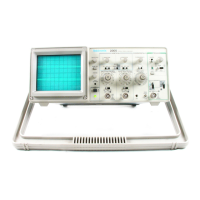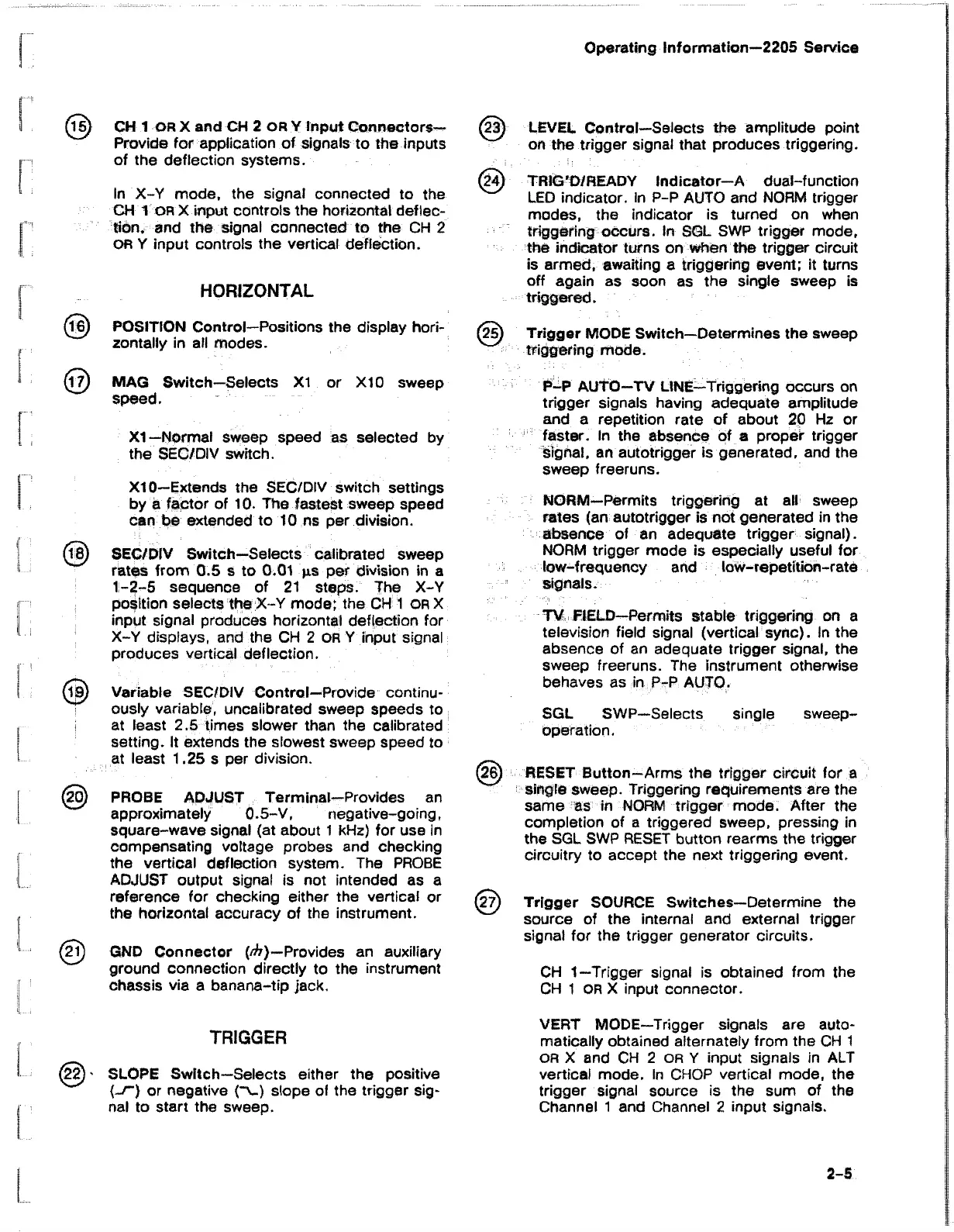Operating Inform ation—2205 Service
(l5 ) CH 1 OR X and CH 2 OR Y Input Connectors—
Provide for application of signals to the inputs
of the deflection systems.
In X-Y mode, the signal connected to the
CH 1 OR X input controls the horizontal deflec
tion, and the signal connected to the CH 2
OR Y input controls the vertical deflection.
HORIZONTAL
Te) POSITION Control—Positions the display hori
zontally in all modes.
(23) LEVEL Control—Selects the amplitude point
on the trigger signal that produces triggering.
(24) TRIG’D/READY Indicator—A dual-function
LED indicator, in P-P AUTO and NORM trigger
modes, the indicator is turned on when
triggering occurs. In SOL SWP trigger mode,
the indicator turns on when the trigger circuit
is armed, awaiting a triggering event; it turns
off again as soon as the single sweep is
triggered.
(25) Trigger MODE Switch—Determines the sweep
triggering mode.
(l_7) MAG Switch—Selects XI or X I0 sweep
speed.
X I—Normal sweep speed as selected by
the SEC/DIV switch.
X I0—Extends the SEC/DIV switch settings
by a factor of 10. The fastest sweep speed
can be extended to 10 ns per division.
(iS) SEC/DIV Switch—Selects calibrated sweep
rates from 0.5 s to 0.01 ji.s per division in a
1-2-5 sequence of 21 steps. The X-Y
position selects the X-Y mode; the CH 1 or X
input signal produces horizontal deflection for
X-Y displays, and the CH 2 OR Y input signal
produces vertical deflection.
(is ) Variable SEC/DIV C ontrol—Provide continu
ously variable, uncalibrated sweep speeds to
at least 2.5 times slower than the calibrated
setting. It extends the slowest sweep speed to
at least 1.25 s per division.
@ PROBE ADJUST Term inal-Provides an
approximately 0.5-V, negative-going,
square-wave signal (at about 1 KHz) for use in
compensating voltage probes and checking
the vertical deflection system. The PROBE
ADJUST output signal is not intended as a
reference for checking either the vertical or
the horizontal accuracy of the instrument.
(21) GND Connector (rh) —Provides an auxiliary
ground connection directly to the instrument
chassis via a banana-tip jack.
P-P AUTO—TV LINE—Triggering occurs on
trigger signals having adequate amplitude
and a repetition rate of about 20 Hz or
faster. In the absence of a proper trigger
Signal, an autotrigger is generated, and the
sweep freeruns.
NORM—Permits triggering at all sweep
rates (an autotrigger is not generated in the
absence of an adequate trigger signal).
NORM trigger mode is especially useful for
low-frequency and low-repetition-rate
signals.
TV FIELD—Permits stable triggering on a
television field signal (vertical sync). In the
absence of an adequate trigger signal, the
sweep freeruns. The instrument otherwise
behaves as in P-P AUTO.
SGL SWP—Selects single sweep-
operation.
(26) RESET Button—Arms the trigger circuit for a
single sweep. Triggering requirements are the
same as in NORM trigger mode. After the
completion of a triggered sweep, pressing in
the SGL SWP RESET button rearms the trigger
circuitry to accept the next triggering event.
(27) Trigger SOURCE Switches—Determine the
source of the internal and external trigger
signal for the trigger generator circuits.
CH 1—Trigger signal is obtained from the
CH 1 OR X input connector.
TRIGGER
{£2) ' SLOPE Switch—Selects either the positive
(_/") or negative ("V ) slope of the trigger sig
nal to start the sweep.
VERT MODE—Trigger signals are auto
matically obtained alternately from the CH 1
OR X and CH 2 or Y input signals in ALT
vertical mode. In CHOP vertical mode, the
trigger signal source is the sum of the
Channel 1 and Channel 2 input signals.
2-5

